Compiled by Geoff Goodall

The
only Northrop Delta to reach Australia, VH-ADR at Mascot Aerodrome,
Sydney 1940 operated by the Department of Civil Aviation.
Photo: Frank Walters Collection
Photo: Frank Walters Collection
The Delta model first flew in May 1933 and received type certification in August that year. Unfortunately the Delta's US airliner market hopes were dashed when United States aviation regulations changed in 1934 to ban singe-engined airliners operating at night or over rough terrain. Instead Northrop concentrated on corporate/executive and military sales. A total of 23 Northrop Deltas were built.
| 35 |
Built by Northrop Corporation at Mines Field, California as model Delta 1D-5 One 735hp Wright SR-1820-F2 Cyclone radial engine. |
| 7.35 |
Registered NC14267 Chicago Real Estate Loan and Trust Co, Chicago, Illinois Used as executive transport for company president George F. Harding |
| 30.7.35 |
Delivery date to Harding |
| 14.1.38 |
Change of ownership: Lincoln Elsworth, Wall Street, New York NY |
| .38 |
Reregistered NR14267
for use on Antarctic Expedition. Modifications included long range fuel
tanks in the cabin to increase fuel capacity from 328 to 553 US gallons. |
| Acquired for Lincoln Ellsworth's fourth and last Antarctic exploration expedition, along with an Aeronca K floatplane NC18888. (Ellsworth had used Northrop Gamma NR12269 "Polar Star" on previous Antarctic expeditions) The Northrop Delta was fitted with skis and carried on the deck of expedition ship Wyatt Earp, while the Aeronca floatplane was carried on a platform at the stern. |
|
| 16.8.38 |
Ellsworth Expedition in Wyatt Earp sailed
from New York for Antarctica via Cape Town, via a stop at Sydney. Left
Cape Town for Antartica on 26.10.38 but bad weather and ice flows
delayed their arrival until early January 1939. The
Aeronca floatplane was used for scouting routes through pack ice
for the ship. |
| 11.1.39 |
Delta
NR14267 on skis took off from Antarctic ice for aerial exploration of
the Antarctic interior, flown by Canadian 'Red' Lymburner accompanied by Lincoln Ellsworth. |
| 1.39 |
Late that month a crew member was seriously injured when crushed by ice and Ellsworth abandoned the expedition, to get him to the nearest hospital, which was Australia |
| 4.2.39 |
Wyatt Earp docked at Hobart, Tasmania. |
| Following recommendations from experienced Antarctic explorer Sir Douglas Mawson, the Australian Government agreed to purchase the Wyatt Earp and its Antarctic equipment for future Australian Antarctic expeditions. The purchase included the two aircraft carried on board. | |
| (The Ellsworth Expedition had sparked tensions between the Australian and US Governments. Allegedly at the request of the US Department of State, Ellsworth had claimed areas of Antarctica in the name of the United States by dropping a canister containing the written claim and a US flag from the Northrop. The areas including land previously claimed by Australia. The Australian Government's highly unusual action of making a benevolent offer to purchase the Wyatt Earp is believed to have triggered by an opportunity to stop Ellsworth returning to Antarctic while at the same time providing equipment for future Australia expeditions - which were delayed by the outbreak of World War II later that year) | |
| 2.39 |
The Northrop was
initially stored with wings removed in a hangar at Mascot Aerodrome,
Sydney before being moved by road to RAAF Richmond where it was stored
until June 1939. While at Richmond it was in the same hangar as Sir
Charles Kingsford-Smith's Fokker trimotor VH-USU Southern Cross also
owned by the Commonwealth Government. The Aeronca was stored in the Royal Aero Club of NSW hangar at Mascot pending a decision on its future. |
| 6.39 |
Aeronca K NC18888 and Northrop Delta NR14267 ownership transferred to Department of Civil Aviation, Melbourne Victoria |
| DCA
decided to
operate the Northrop on radio navigation aid calibration work to
replace a Guinea Airways Lockheed 10 Electra currently on charter for
that purpose. The
Aeronca was offered to aero clubs and sold by DCA to Canberra Aero Club
on favourable financial terms. |
|
| 15.6.39 |
Delta flown Sydney-Melbourne by DCA Senior Flying Inspector J.Kerr. |
| Australian CofA overhaul carried out at Essendon Aerodrome, Melbourne by Australian National Airways (ANA) | |
| 15.8.39 |
Delta NR14267 cancelled from US Civil Aircraft Register |
| 16.8.40 |
Registered VH-ADR: Commonwealth of Australia, Department of Civil Aviation, Melbourne Victoria |
| 9.40 |
Australian CofA issued. Seating for pilot plus 5 passengers |
| Operated
by DCA to calibrate and test the new Lorenz Radio Range
navigation aid equipment being installed along main Australian air
routes. |
|
| 24.7.42 |
Operated by DCA until 24 July 1942 when it was released on charter to the Directorate of Air Transport, Allied Air Force, South-West Pacific Area and operated by the US Army Air Forces in Australia. Feried
from Essendon to Geraldton WA. When the USAAF unit moved north, the
elta was handed ove to RAAF in WA. here it was taken over by the RAAF
on 3 August when the USAAF unit operating it moved north. The RAAF
returned the aircraft to DCA at Essendon on 17 September after an
engine overhaul and some 60 hours flying, terminating the DAT charter. |
| 3.8.42 |
Handed over to RAAF in WA. |
| 17.9.42 |
Arrived back at Essendon on delivery to DCA. |
| Aircraft engineer and later commercial pilot Harry Moss in his book "10,000 Hours" describes his period 1941-43 employed as a ground engineer by DCA at the Departmental hangar at Essendon. Among
other jobs he had modified a DH.50 VH-UAB with a 450hp P&W Wasp and
accompanied DCA pilot Arthur Affleck on its ferry flight to New
Guinea 11.42, where it was planned be used to evacuate wounded troops
from the Kokoda Trail. After his return to Essendon in late November 1942, Moss wrote: "My first job on my return was to check over a Northrop Delta that DCA had in Melbourne. It was a handsome sophisticated all metal low wing monoplane powered by a Wright Cyclone. Its comprehensive radio, instrumentation and navigation gear was in first class condition, but the aeroplane had been battered by hail and ice on the Antarctic expedition and the cyclone engine rather tired. The RAAF had their eyes on it for communications work. As soon as we got it as good as we could get it, they flew it away and we never saw it again." |
|
| 12.42 |
Transferred from DCA to Department of Air for use by RAAF |
| 11.12.42 |
Taken on RAAF charge as A61-1. Received No.1 Aircraft Depot, Laverton |
| 16.1.43 |
Received 35 Squadron Pearce ex 1AD |
| During
March 1942 RAAF HQ formed four new squadrons dedicated to the transport
role: Nos.33 to 36 (Transport) Squadrons. Each commenced with
inadequate small aircraft while negotiations began with the American
Government for the release of new and used Douglas C-47s. No.35 Squadron was formed at Pearce on 11.3.42 with initial equipment Fox Moth, Tiger Moths, Dragons, Ansons, Battles and later the Northrop Delta. 35 Squadron deployed its aircraft to Perth's civilian aerodrome Maylands because of congestion at RAAF Pearce where additional squadrons were arriving to patrol the West Australian coastline against expected Japanese invasion. In April 1942 the Royal Aero Club of WA clubhouse at Maylands was taken over by the RAAF for use by 35 Sqn personnel. In August 1943 RAAF presence at Maylands ended when 35 Squadron relocated to Pearce to re-equip with C-47 Dakotas. |
|
| Indications are that A61-1 was rarely flown while with 35 Squadron at Maylands. RAAF Airframe Record card has no entries for its time with 35 Sqn. Former Royal Aero Club of WA President Robert O.Giles wrote of his own observations in his book on the history of the club "Wings In The West": "The Northrop long-range monoplane spent most if its time grounded at Maylands awaiting new engine parts. When the parts finally did arrive, the aircraft was promptly allotted back to Melbourne." |
|
| 28.7.43 |
Issued to No.34 Squadron ex 35 Sqn |
| 29.7.43 |
Reallotted No.37 Squadron ex 34 Sqn No.37 (Transport) Squadron was a fifth transport unit, formed at RAAF Laverton 15.7.43. |
| 2.8.43 |
37 Sqn Operations Book: A61-1 Northrop Delta arrived at 37 Sqn Laverton on 2.8.43. It was the unit's first aircraft prior to receiving Lockheed Lodestars, the first Lodestar A67-5 arrived Laverton 28.8.43. |
| 21.9.43 |
37 Sqn Operations Book: A61-1 departed Laverton for Tocumwal, Wagga, Parkes to Sydney, flown by Squadron Leader K.G.Caldwell. |
| 30.9.43 |
Swung on takeoff, significant airframe damage. No location quoted. Initial report states cause was tailwheel strut collapsing |
| 19.10.43 |
Damaged airframe received No.2 Aircraft Depot, Richmond. Stored dismantled. |
| 10.43 |
The Delta's Wright Cyclone GR1820 engine serial 22365 was sent to 5AD Wagga for inspection and repair. |
| Ansett
Airways, Melbourne approached DCA
wishing to acquire the damage Delta to repair for its
Melbourne-Hamilton airine service. It was being maintained by Ansett's
AirspeedEnvoy VH-UXM and Percival Q.6 VH-ABY on loan from DCA. RAAF
responded that the Delta could not be repaired due inability to source
airframe spare parts. |
|
| 22.4.44 |
Dismantled airframe photographed stored outside at RAAF Richmond |
| 25.7.44 |
Issued to No.2 Central Recovery Depot, Richmond for conversion to components |
| Broken up for parts at RAAF Richmond |
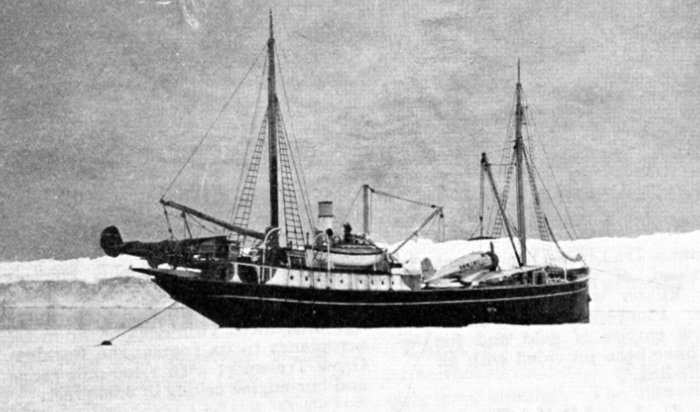
stowed at the stern. Photo via Graham Orphan

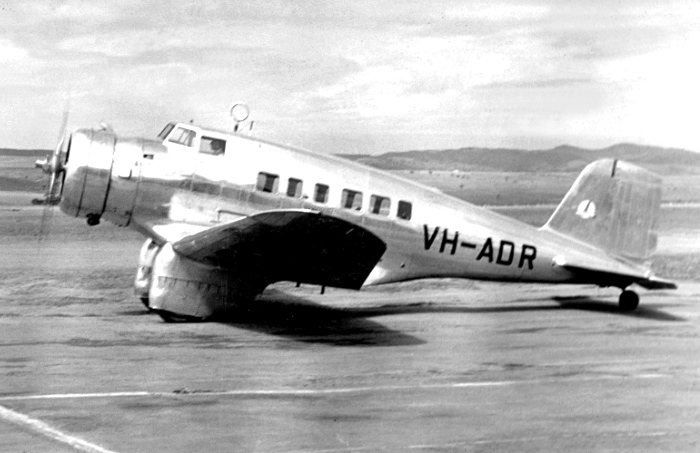
Now
VH-ADR with Department of Civil Aviation, visiting Parafield SA circa
1940. Civil Aviational Historical Society
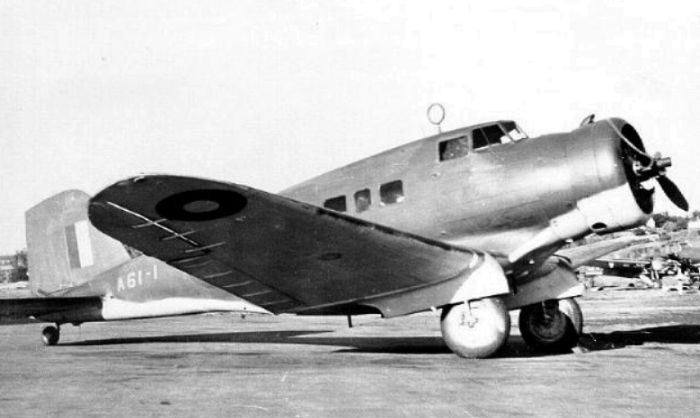
Maylands Aerodrome, Perth, where 35 Squadron deployed their aircraft. Lower sections of the undercarriage fairings
are removed, probably for use on rough dirt strips Both photos: RAAF, via Civil Aviation Historical Society
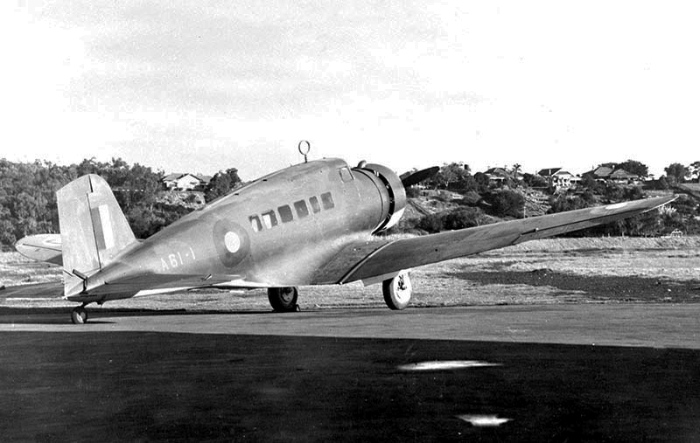
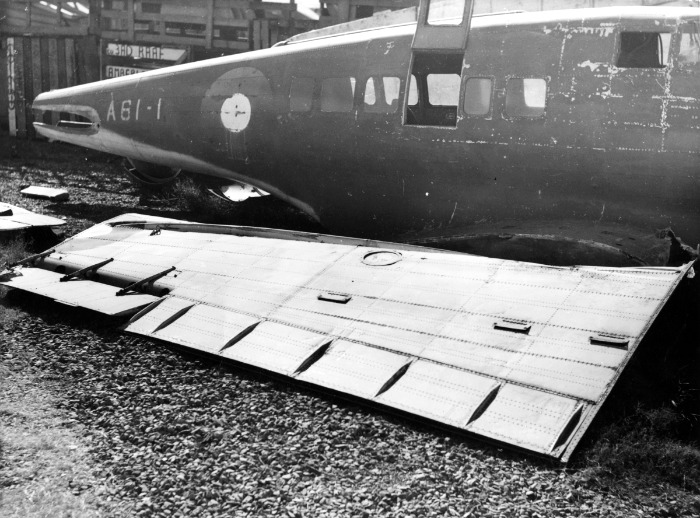
These last two photographs were taken on 22 April 1944 at RAAF Richmond, where the damaged Delta was held by 2AD
pending a decision in its fate. Photos: RAAF via Civil Aviation Historical Society
pending a decision in its fate. Photos: RAAF via Civil Aviation Historical Society

- Australian Civil Aircraft Register, Department of Civil Aviation and its successors
- RAAF Airframe record card A61-1
- No.37 Squadron Operations Record Book 1943: extracted by Melvyn Davis
- ADF Serials website: A61-1
- Trove Newspaper Search - National Library of Australia
- Civil Aviation Historical Society website: DCA aircraft fleet listing
- McDonnell Douglas Aircraft since 1920, Rene J. Francillon, Putnam 1979
- 10,000 Hours, Harry V. Moss, Hesperian Press 1988
- Wings in the West, R.O. Giles, Royal Aero Club of WA 1978